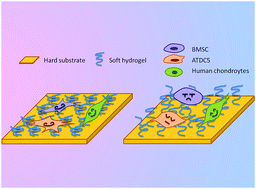当前位置:
X-MOL 学术
›
J. Mater. Chem. B
›
论文详情
Our official English website, www.x-mol.net, welcomes your feedback! (Note: you will need to create a separate account there.)
Cells may feel a hard substrate even on a grafted layer of soft hydrogel†
Journal of Materials Chemistry B ( IF 7 ) Pub Date : 2018-02-23 00:00:00 , DOI: 10.1039/c7tb02967e Shuhao Wang 1, 2, 3, 4, 5 , Fei Zan 1, 2, 3, 4, 5 , Yu Ke 2, 3, 6 , Gang Wu 1, 2, 3, 4, 5
Journal of Materials Chemistry B ( IF 7 ) Pub Date : 2018-02-23 00:00:00 , DOI: 10.1039/c7tb02967e Shuhao Wang 1, 2, 3, 4, 5 , Fei Zan 1, 2, 3, 4, 5 , Yu Ke 2, 3, 6 , Gang Wu 1, 2, 3, 4, 5
Affiliation

|
Introducing or grafting molecules onto biomaterial surfaces to regulate cell destination via biophysical cues is one of the important steps for biomaterial design in tissue engineering. Understanding how cells feel the substrate makes it easier to learn the mechanism behind cell–material interaction. In this study, on a glass substrate, we constructed poly-phenoxyethyl methacrylate (PHEMA) brushes having different lengths via a surface-induced atom transfer radical polymerization (SI-ATRP) method. FTIR-ATR and XPS tests of the formed polymer brushes indicate that these brushes have characteristic chemical structures of PHEMA; the polymer brush length revealed by the AFM tests increases linearly with reaction time. Cell lines of BMSCs, ATDC5, and human chondrocytes (HC) were cultured on these substrates to evaluate proliferation, adhesion, and differentiation. Our results demonstrated that the cells cultured on the substrates with short PHEMA brushes developed a spread morphology and organized actin fibers as compared to the cells cultured on those with long brushes. Different cell lines showed different responses depending on the PHEMA brush length. Cells cultured on long PHEMA brushes displayed a more rounded shape, higher gene expression of FAK and integrin, and lower gene expression of NCAM and N-cadherin as compared to those, especially ATDC5 cells, cultured on short PHEMA brushes. On PHEMA brushes with a long length, the cell lines express higher cartilage-specific genes including Sox9 and Col2 and GAG in ECM. The results suggest that polymer brushes having different lengths may interfere with the behavior of the cells cultured on them.
中文翻译:

即使在接枝的软水凝胶层上,细胞也可能会感觉到坚硬的基质†
将分子引入或移植到生物材料表面上以通过生物物理线索调节细胞位置是组织工程中生物材料设计的重要步骤之一。了解细胞如何感受底物,使学习细胞与材料相互作用的机制变得更加容易。在这项研究中,我们在玻璃基板上构造了具有不同长度的聚甲基丙烯酸苯氧基乙酯(PHEMA)刷子。表面诱导的原子转移自由基聚合(SI-ATRP)方法。所形成的聚合物刷的FTIR-ATR和XPS测试表明,这些刷具有PHEMA的特征化学结构。AFM测试揭示的聚合物刷长度随反应时间线性增加。在这些底物上培养BMSC,ATDC5和人软骨细胞(HC)的细胞系,以评估其增殖,粘附和分化。我们的结果表明,与在长刷上培养的细胞相比,在短PHEMA刷上培养在底物上的细胞具有扩展的形态和组织化的肌动蛋白纤维。不同的细胞系显示出不同的响应,具体取决于PHEMA刷的长度。用长PHEMA刷子培养的细胞显示出更圆的形状,FAK和整联蛋白的基因表达更高,与在短PHEMA刷上培养的NCAM和N-cadherin的基因表达(尤其是ATDC5细胞)相比,表达降低。在长长度的PHEMA刷子上,细胞系表达ECM中较高的软骨特异性基因,包括Sox9和Col2以及GAG。结果表明,具有不同长度的聚合物刷可能会干扰在其上培养的细胞的行为。
更新日期:2018-02-23
中文翻译:

即使在接枝的软水凝胶层上,细胞也可能会感觉到坚硬的基质†
将分子引入或移植到生物材料表面上以通过生物物理线索调节细胞位置是组织工程中生物材料设计的重要步骤之一。了解细胞如何感受底物,使学习细胞与材料相互作用的机制变得更加容易。在这项研究中,我们在玻璃基板上构造了具有不同长度的聚甲基丙烯酸苯氧基乙酯(PHEMA)刷子。表面诱导的原子转移自由基聚合(SI-ATRP)方法。所形成的聚合物刷的FTIR-ATR和XPS测试表明,这些刷具有PHEMA的特征化学结构。AFM测试揭示的聚合物刷长度随反应时间线性增加。在这些底物上培养BMSC,ATDC5和人软骨细胞(HC)的细胞系,以评估其增殖,粘附和分化。我们的结果表明,与在长刷上培养的细胞相比,在短PHEMA刷上培养在底物上的细胞具有扩展的形态和组织化的肌动蛋白纤维。不同的细胞系显示出不同的响应,具体取决于PHEMA刷的长度。用长PHEMA刷子培养的细胞显示出更圆的形状,FAK和整联蛋白的基因表达更高,与在短PHEMA刷上培养的NCAM和N-cadherin的基因表达(尤其是ATDC5细胞)相比,表达降低。在长长度的PHEMA刷子上,细胞系表达ECM中较高的软骨特异性基因,包括Sox9和Col2以及GAG。结果表明,具有不同长度的聚合物刷可能会干扰在其上培养的细胞的行为。



























 京公网安备 11010802027423号
京公网安备 11010802027423号